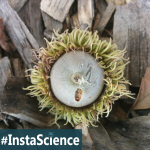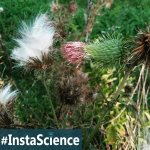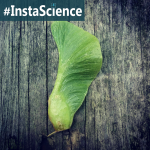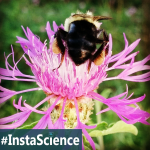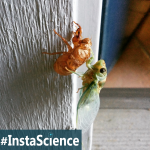When one thinks of fall, we almost immediately envision pumpkins! Big, fat, orange pumpkins. But there are lots of different varieties of pumpkins – some are big and orange, some are brownish with long necks, and some are blue! Inside, pumpkins all have a yellowish-orange flesh. Did you know that pumpkins are fruits? And that pumpkins are most closely related to cucumbers, squashes, and … [Read more...]
Acorns {InstaScience}
I love acorns! And my absolute favorite is this one from the Burr Oak tree. Isn’t it gorgeous? Acorns are the seeds of oak trees. Each one has a cap, which is attached to the tree, a hard shell, which protect the seed inside when it falls from the tree. And the seed, which will develop into a new oak tree the next year that is if the blue jays, chipmunks, and squirrels don’t eat first! Oak … [Read more...]
Bull Thistle {InstaScience}
Bull Thistle is one of those "weeds" that almost all of us are familiar with! Its characteristic purple flowers are easy to spot as they adorn the top of the stem. Plus, its spiky stem acts like a sentinel on the border of vacant fields and along trails. This weed definitely prefers wide, open, sunny areas! But did you know that the flowering stems you see are actually the second year … [Read more...]
Maple Copters {InstaScience}
These days, my kids are finding the ground littered with nature's helicopters - the maple seed! We always stop, pick up a few, let them go, and watch nature take flight. Maples produce these helicopter-like seeds in late summer or early fall. They vary in size, shape, and color based on the species of maple they come from. The seed pods have a wing that grows out from the ovary where the … [Read more...]
Bees & Pollen {InstaScience}
Check out the legs on this bee! It is not pumping iron, it's packing pollen! Literally hundreds of the tiny grains are resting on its pollen sacs waiting for the flight home. Bees have special combs on their front legs that they use to brush the pollen off their bodies and onto the sticky pollen sacs found on their hind legs. From flower to flower, the pollen builds up giving the bee one … [Read more...]
Cicada Emergence {InstaScience}
Every once in awhile you walk out the door and find something amazing. That was the case when Paige found this adult cicada emerging right on the frame of their front door! Cicadas, like butterflies, undergo complete metamorphosis. The nymphs spend at least a year or two underground feeding on sap from tree roots. They emerge in July, find a safe place, and spend the next hour or so … [Read more...]
 Sign up below to receive weekly tips & tools for homeschool science and we'll send you a FREE copy of
Sign up below to receive weekly tips & tools for homeschool science and we'll send you a FREE copy of 
